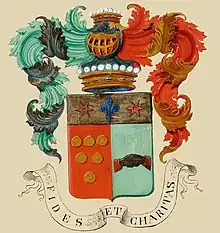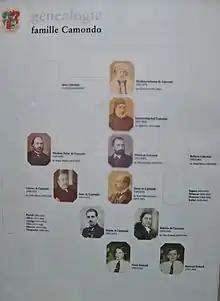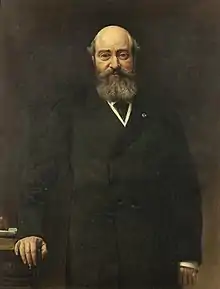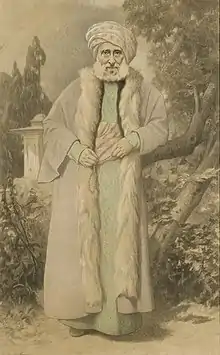House of Camondo
The Camondo family was a prominent European family of Jewish financiers and philanthropists.


History

Part of the Sephardic community in Spain, the Camondo family settled in Venice after the 1492 Spanish decree that ordered the expulsion of all Jews who refused conversion to Catholicism. There, some of its members became famous for their scholarship and for the services which they rendered to their adopted country. Following the Austrian takeover of Venice in 1798, members of the Camondo family travelled between Vienna and Istanbul. Despite the many restrictions and sumptuary laws imposed on non-Muslims, the family flourished as merchants in the business section at Galata on the outskirts of the city. They branched into finance in 1802 with the founding of their own bank, Isaac Camondo & Cie.
On Isaac's death in 1831, his brother Abraham Salomon Camondo inherited the bank. He prospered greatly and became the prime banker to the Ottoman Empire until the founding of the Imperial Ottoman Bank in 1863. In 1865, he relinquished his Austrian citizenship to become a national of the newly created Kingdom of Italy.[1]: 77 In recognition of his contributions and financial assistance to the liberation of Venetia from the Austrian Empire, Abraham Salomon Camondo was created a hereditary count in 1870 by King Victor Emmanuel II of Italy. The operations of the Camondo bank reflected the transformation of the Jewish community in Constantinople and beyond it, of the Ottoman financial system. Its ledger of real estate transactions was originally held in Hebrew from 1833 to 1858, then in Italian until 1866, then in French.[1]: 74–75

In 1869, Abraham Salomon Camondo's grandsons Abraham Behor Camondo (1829–1889) and Nissim Camondo (1830–1889) moved to Paris, France, a city the family had previously frequented and where they had established business connections. Abraham Salomon soon followed them and died in Paris in 1873, but in accordance with his wishes, his remains were returned to Istanbul for burial there in the Jewish cemetery at Hasköy, a neighbourhood on the Golden Horn in Istanbul. His two grandsons remained in Paris and continued to successfully expand the banking business from there until their respective deaths, both in 1889, while keeping a strong link with their native Constantinople.
The next generation, cousins Isaac and Moïse Camondo, both based in Paris, did not display interest in further developing the family business. The banking operations in Constantinople were closed by decision of Isaac Camondo in 1894.[1]: 213
The banking branch of this family is now extinct after the last descendants died: Nissim de Camondo was killed in aerial combat during World War I in 1917, his father Moïse de Camondo died in 1935, then his sister Béatrice de Camondo, along with her two children (Fanny and Bertrand) and her ex-husband Léon Reinach, were deported and murdered in Auschwitz around 1944 during World War II. Nevertheless, there are several living descendants of Isaac Camondo (Abraham Salomon's brother and founder of the bank).
Principal members of the Camondo family
Principal members of the Camondo family include:
- Abraham Salomon Camondo (1781–1873), Jewish-Turkish banker and philanthropist
- Rafael Camondo (1810–1866)
- Abraham Behor Camondo (1829–1889)
- Isaac de Camondo (1851–1911)
- Nissim Camondo (1830–1889)
- Moïse de Camondo (1860–1935), French banker and art collector
- Nissim de Camondo (1892–1917), French banker and World War I pilot
- Béatrice de Camondo (1894–1944), French socialite
- Moïse de Camondo (1860–1935), French banker and art collector
- Abraham Behor Camondo (1829–1889)
- Rafael Camondo (1810–1866)
Notable buildings associated with the Camondo family
Paris
The Musée Nissim de Camondo is located in the 8e arrondissement in Paris, at 63, rue de Monceau, where Nissim Camondo lived from 1870 until his death in 1889, then his widow Elise until 1910. The property was then inherited by Moïse de Camondo who had it torn down and rebuilt on a design by architect René Sergent, inspired by the Petit Trianon in Versailles.[1]: 317 The building and its contents have been preserved in their state at the death of Moïse Camondo in 1935.
From the late 1870s Abraham Behar Camondo lived at 61 rue de Monceau, next door to his brother Nissim. He bought the land in 1870 and had a mansion built there on a design by architect Denis-Louis Destors, who also remodeled Nissim's house at number 63.[1]: 148–149 His son Isaac de Camondo sold the estate in 1893 to industrialist Gaston Menier.[1]: 233 In 1946 it became the headquarters of the Pompey Steelworks, which purchased it from the Meniers. Its interior arrangements were demolished in the late 1970s. In 2005, it became the Paris office of Morgan Stanley.[2]
The Camondo bank's offices in Paris were at 31, rue La Fayette.[1]: 170
Camondo Palace

The seaside mansion of the Camondo family, popularly known as the Camondo Palace (Kamondo Sarayı),[3] was built between 1865 and 1869 and designed by architect Sarkis Balyan.[4][5] It is located on the northern shore of the Golden Horn, within the Kasımpaşa quarter of the Beyoğlu district, to the west of Galata (Karaköy). It later became the headquarters of the Ministry of the Navy (Bahriye Nezareti)[4][5] during the late Ottoman period, and is currently used by the Turkish Navy as the headquarters of the Northern Sea Area Command (Kuzey Deniz Saha Komutanlığı).)[3][4][5]
Camondo Apartment Buildings
The Camondo family also built two historic apartment buildings in Galata, both of which are named Kamondo Apartmanı: the older one is located at Serdar-ı Ekrem Street near Galata Tower and was built between 1861 and 1868;[3] while the newer one is located at the corner between Felek Street and Hacı Ali Street and was built in 1881;[6] it was later converted into the upscale Galata Residence Hotel.[7]
Camondo Steps
The Camondo Steps, a famous pedestrian stairway designed with a unique mix of the Neo-Baroque and early Art Nouveau styles, was built in circa 1870–1880 by Abraham Salomon Camondo. It forms the part of Bereketzade Medresesi Sokağı (Bereketzade Madrasa Street) that connects Bankalar Caddesi (Banks Street) with Banker Sokak (Banker Street) in the Galata (Karaköy) quarter of Istanbul.[8]
See also
References
Notes
- Nora Şeni; Sophie Le Tarnec (1997). Les Camondo, ou l'éclipse d'une fortune. Babel / Actes Sud.
- "Le 61 rue de Monceau, l'autre hôtel Camondo". Musée des Arts Décoratifs. 2019.
- Kamondo Apartmanı (1868) at Serdar-ı Ekrem Street Archived 2014-02-22 at the Wayback Machine
- Bahriye Nezareti (Ministry of the Navy) building
- Bahriye Nezareti (Ministry of the Navy) building Archived 2014-02-21 at the Wayback Machine
- National inventory of historic buildings: Kamondo Apartmanı (1881) between Felek Street and Hacı Ali Street Archived 2014-02-21 at the Wayback Machine
- "Galata Residence Hotel". The Finest Hotels of the World.
- "Camondo Steps on the Bankalar Caddesi". Archived from the original on 2011-09-03. Retrieved 2014-02-18.
Further reading
- Assouline, Pierre (1999). Le Dernier des camondo (in French). Gallimard. ISBN 978-2-07-041051-4.
- Malino, Frances; Sorkin, David (1991). "Abraham de Camondo of Istanbul: The Transformation of Jewish Philanthropy". From East and West: Jews in a Changing Europe 1750–1870. Blackwell. pp. 46–56. ISBN 978-0-631-16602-3.
- Seni, Nora (1994). "The Camondos and Their Imprint on 19th-Century Istanbul" (PDF). International Journal of Middle East Studies. 26 (4): 663–675. doi:10.1017/S002074380006116X.
External links
- Camondo family tree (in French)
